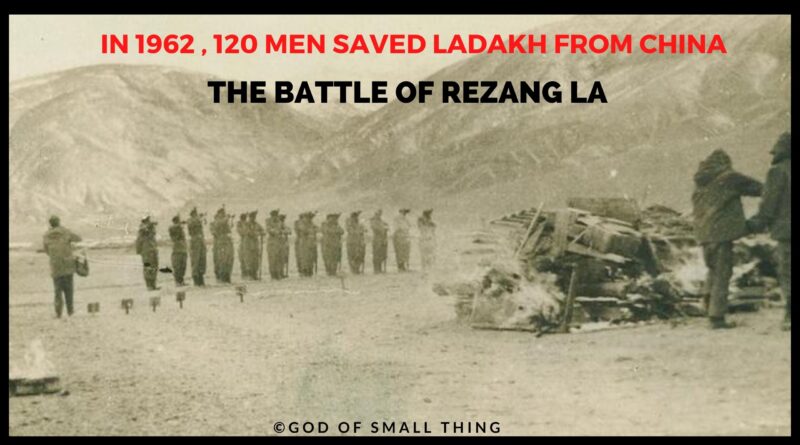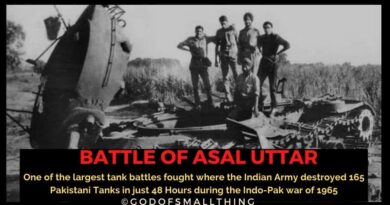Greatest last stands in Military history: The Battle of Rezang La (Indo-China War 1962 )
In a struggle against 5,000 powerful Chinese troops, 120 poorly armed and vastly outnumbered members of the Charlie Company of the 13 Kumaon Regiment fought for nearly 6 hours in the frigid heights of Rezang La in Ladakh and killed over 1200 Chinese troops. Very Few people are aware that Chinese forces kept a helmet on top of an Indian soldier’s head and planted a bayonet next to his head after the battle as a tribute to Braveheart, who died after stomping on the heads of opposing soldiers with his bare hands. The deceased soldier was identified as Naik Singh Ram of Haryana, who was awarded the Vir Chakra. The little-known information was revealed at the Gomti Book Fair Festival by novelist and former Indian Coast Guard commander Kulpreet Yadav in conversation with Lt Col Yuvraj Malik, the NBT’s director. After four years of research, Kulpreet, who retired in 2014, published his book on the Rezang La combat in September 2021.
Not the kind of strength to be understood in terms of military readiness or tactical skill — Indian troops were vastly outnumbered, weren’t as well adapted to winter conditions as their Chinese counterparts, had inferior weaponry, and, more importantly, the height of mountain tops interfered with the flight of artillery shells. However, on that freezing night of November 18, 1962, the troops of the Charlie Company of 13 Kumaon showed what sort of strength it needed to battle to “the last man, last round.”
Table of contents
Battle of Rezang La 1962

One such conflict that every Indian desires to erase from his memory and heart is the Indo-China War of 1962. China’s attack forced India to sustain significant losses and casualties. However, there is always one heroic tale that, even 60 years later, makes Indians proud. The protagonist of the story is Major Shaitan Singh.
One of the greatest last stands in military history is forever associated with the Battle of Rezang La.
The battle is notable for the utmost bravery, tenacity, and unwavering resolve of C Company of 13 KUMAON who, in the 1962 war against China, defended Rezang La in Eastern Ladakh while being led by the charismatic Major Shaitan Singh. A famous example of Indian might during the 1962 conflict is the Battle of Rezang La, which was fought between Indian & Chinese troops on the cold mountain summits on the southeast slope of the Chushul Valley.
One more such heroic story of valor and great courage by the Indian Army is the story of 1971 Battle Of Longewala
Background of Battle of Rezang La
Rezang La, also known as Rechin La, is a mountain pass that runs along the Line of Actual Control between the Chinese-administrated Spanggur Lake basin and Ladakh, which is also claimed by India. The pass is situated on the ridge of the Chushul Valley’s eastern watershed, which China claims to be its border. It is located near the entrance to the Rezang Lungpa Valley, where a stream empties into Spanggur Lakes.
A pass leading to another valley known as “Rezang Lungpa” is located about 3 km southeast of Rechin La (33°24′52′′N 78°52′29′′E). This pass is known as Rezang La in China. A significant fight of the 1962 Sino-Indian War took place in another pass, which is located about 3 km northwest of Rechin La (33°26′38′′N 78°49′48′′E).
The 120-person company led by Major Shaitan Singh held against more than 1000 Chinese forces at a height of more than 18,000 feet until they ran out of ammo. In fact, it is believed that the determined Indian soldiers engaged the Chinese, who were more numerous and well-equipped, in hand-to-hand combat even after their ammunition ran out. This is regarded as a singular episode in the annals of contemporary warfare.
Battle of Rezang La Date
Out of a total of 120 Indian soldiers, 114 died in combat on November 18, 1962, while more than 1000 Chinese soldiers were also slain. According to a memorial in Rewari, where the majority of the Ahir warriors were from, 1,300 Chinese soldiers perished in the conflict.
In that grieving scenario, the battle of Rezang La was the last stand against the Chinese troops. With commendable courage, the C Company of 13 Kumaon fought against China, defending Rezang La in Eastern Ladakh under the exceptional leadership of Major Shaitan Singh.
Battle of Rezang La: The War
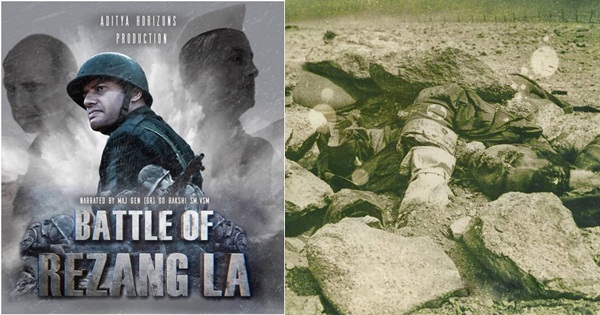
After November 17, the soldiers of Charlie Company began providing information about the approach of the Chinese army and their equipment from their patrol posts in the field. They were advancing on India while carrying artillery guns. In no time, hundreds of Chinese vehicles transporting soldiers and equipment had reached the location. On November 18, 1962, China launched its first attack, sparking a conflict between India and China. There was hand-to-hand combat between the two nations. Major Shaitan Singh was hurt in the shooting and passed away immediately.
The Battle of Rezang La is frequently regarded as a demonstration of the enormous power of India during the war in 1962. Not the kind of strength to be understood in terms of military readiness or tactical skill — Indian troops were vastly outnumbered, weren’t as well adapted to winter conditions as their Chinese counterparts, had inferior weaponry, and, more importantly, the height of mountain tops interfered with the flight of artillery shells. However, on that freezing night of November 18, 1962, the troops of the Charlie Company of 13 Kumaon showed what sort of strength it needed to battle “the last man, last round.”
114 of the company’s 120 men and officers passed away. Nevertheless, they were able to kill nearly a thousand people on the other side. This is even more astounding when you consider that every soldier in the company—aside from their Rajput commander—was an Ahir from the Haryana regions of Gurgaon and Mewat, where they originated from farming and cattle-raising clans. For them, serving at – 30 degrees was a first, and the majority had never participated in an active action outside of Jammu and Kashmir. This may be the reason why the Charlie Company of the 13 Kumaon Battalion is the most decorated company in Indian Army history.
Heroes of Battle of Rezang La
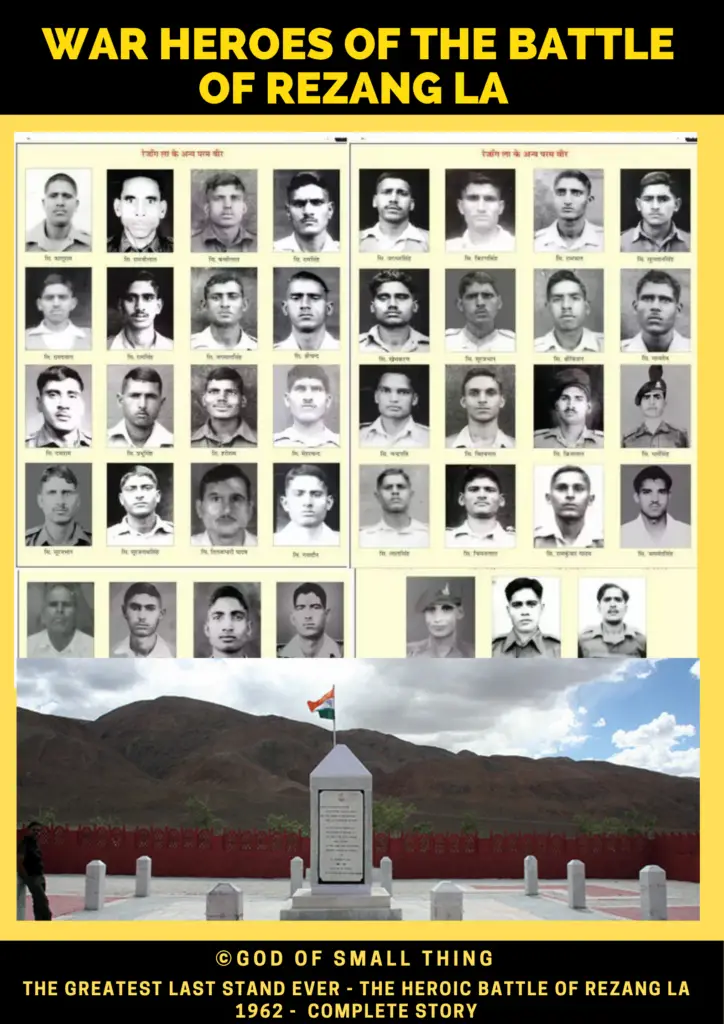
Protecting our borders in the most unfavourable conditions, the Indian soldiers who fought for our country in the battle of Rezang La, are a source of inspiration for the entire nation. The names of the brave men from the battalion will always remind us of our great military legacy and the power of absolute determination. The soldiers of 13 KUMAON were honoured with one Param Vir Chakra, eight Veer Chakras, one Ati Vishisht Seva Medal, four Sena Medals, and one Mention-in-Despatches. Their contribution will always be remembered and future generations will always find the courage in the memory of the men of the 13 Kumaon who laid down their lives fighting for their motherland.
At a height of more than 18,000 feet, the 120-person company under the command of Major Shaitan Singh held against more than 1000 Chinese forces until their ammunition ran out. The heroes who were awarded the Vir Chakra in 1962 for defending Rezang La were
- Jemadars Hari Singh,
- Jemadar Surja,
- Naik Hukam Ram,
- Naik Gulab Singh Yadav,
- Lance/Naik Singh Ram,
- Sepoy Nursing Assistant Dharam Pal Dhaiya (all posthumous),
- Jemadar Ram Chander and Naik Ram Kumar.
While Sena Medals were awarded Company
- Havildar Major Harphool Singh (posthumously),
- Havildars Jai Narain,
- Phul Singh and Sepoy Nihal Singh
- While Havildar Jai Narain was Mentioned in Despatches.
Meet Baba Harbhajan Singh: A Man Protecting The Border’s Even After Death!! – Indian Army Baba Harbhajan Singh
Major Shaitan Singh
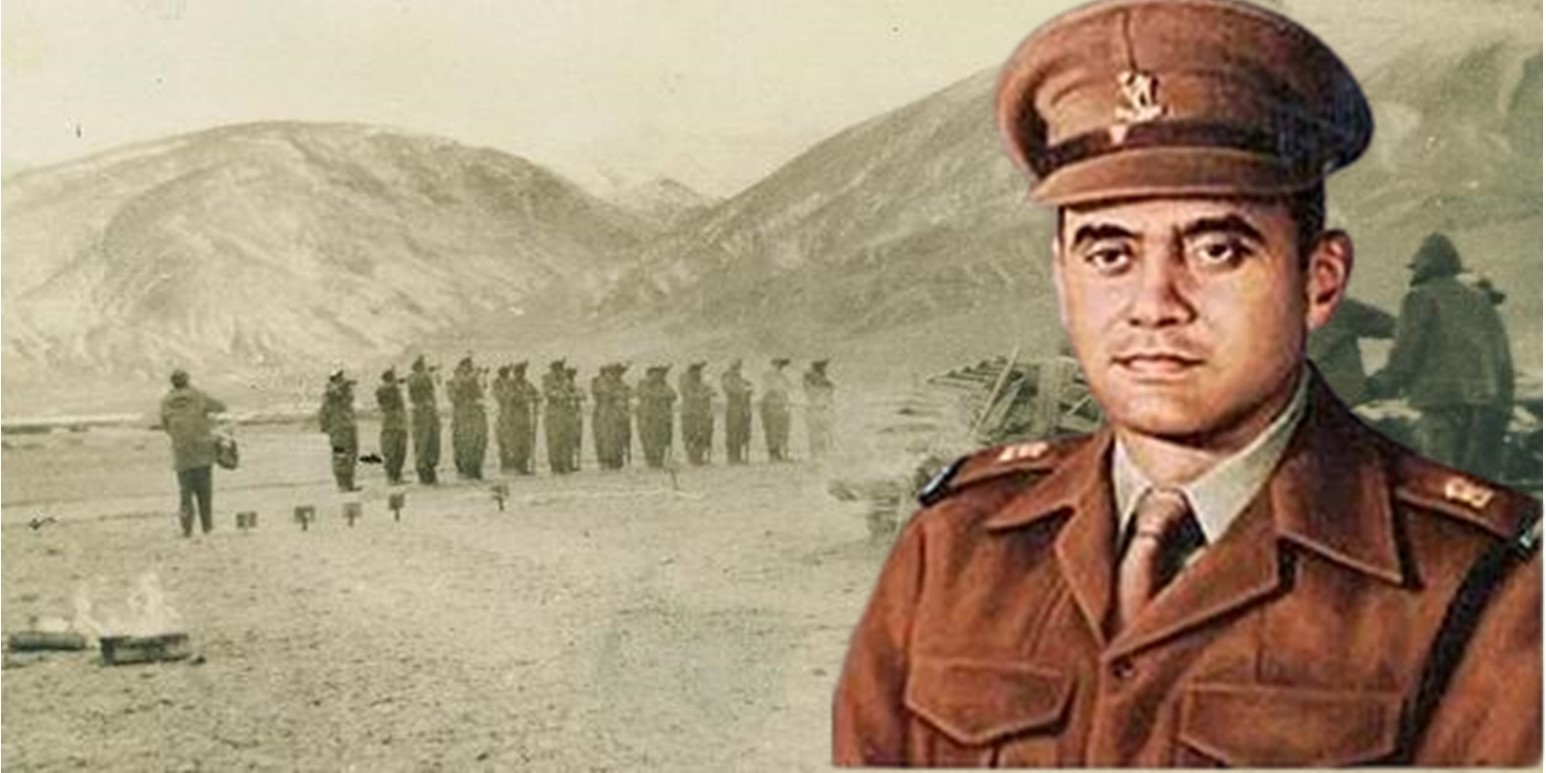
Talking about the Battle of Rezang La without bringing up Major Shaitan Singh, the Charlie company commander and recipient of the Param Vir Chakra, would be incorrect. Talking about the Battle of Rezang La without bringing up Major Shaitan Singh, the Charlie company commander and recipient of the Param Vir Chakra, would be incorrect. He went from one station to another as the Chinese soldiers attacked his platoons in order to keep his comrades’ spirits up.
He went from one station to another as the Chinese soldiers attacked his platoons in order to keep his comrades’ spirits up. This was done at tremendous personal risk because he was hit by enemy fire twice—once in the arm and once in the belly. Two of his soldiers then pushed him behind a boulder to seek cover.
Months later, his frozen remains and the bodies of other members of his army were discovered next to that boulder.
An officer in the Indian Army, Major Shaitan Singh. He received the Param Vir Chakra posthumously in recognition of his exceptional bravery and leadership during the Sino-Indian War in 1962. He is thought to be just the second soldier to get this highest heroism honour. Months later, his frozen remains and the bodies of other members of his army were discovered next to that boulder. A search crew made up of Indians discovered the frozen bodies on the battlefield in February 1963, some of which were still holding onto their weapons.
The Battle of Rezang La – How dog turned saviour
Five troops from the Indian side were taken prisoner of war by Chinese forces. Platoon leader Naib Subedar Ram Chander was one of them; he was captured while unconscious and freed six months later. Intriguing incidents like the one involving Havaldar Nihal Singh, who managed to flee a day after being brought in by Chinese soldiers, also occurred.
“The troops that detained me were moving around and conversing. By this time, it had grown dark, and I realised I should leave. I left from there quietly. They fired three rounds into the air as I moved about 500 metres,” Singh remembered in an interview 50 years later. According to some stories, Singh recalls encountering a dog while fleeing, and it was the stray dog that directed him to the battalion headquarters.
“This dog had been fed a couple of times by the Charlie Company in October when they had first arrived. The dog gave him a quick glance before turning to move in a specific direction. After following the dog for a while, Sep. Nihal Singh eventually arrived at the battalion headquarters,” according to Yadav.
The Battle of Rezang La – Conclusion
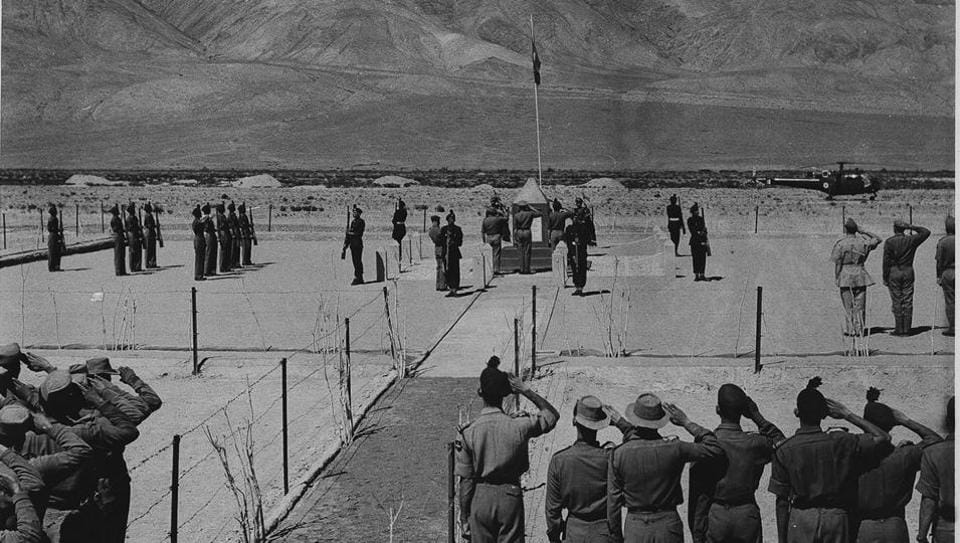
After India’s independence, the battle of Rezang La has a prominent place in its history. The conflict took place in 1962 during the Sino-China war. The last stand of the Charlie ‘C’ Ahir company of the 13 Kumaon, which was composed of 124 Indian men, took place at the Rezang La pass, making it significant in the battle.
The Battle of Rezang La – Honours
One Param Vir Chakra, eight Veer Chakras, an Ati Vishisht Seva Medal, four Sena Medals, and a Mention-in-Despatches were awarded to the men of 13 KUMAON. These names, which are inscribed on the battalion’s colours, will always serve as a reminder of the courageous men who gave their lives on November 18, 1962, while defending our nation.
The 114 Bravehearts of the Chushul Brigade were honoured at the Rezang La Memorial on Friday in honour of the 60th anniversary of the Battle of Rezang La by Shri Giridhar Aramane, IAS, Defence Secretary, Lt Gen A Sengupta, General Officer Commanding Fire and Fury Corps, Maj Gen V Hariharan, General Officer Commanding Uniform Force, and Naresh Shaukand, DIG (Operations), ITBP.
Have you heard of Sikkim Scouts? It is the youngest Indian Army Regiment like no other “Sikkim Scouts- Guardians of Honour” – God of Small Thing
Rezang La War Memorial (Ahir Dham)
By defending their homeland at Rezang La in Ladakh, which is located at a high altitude and is blasted by freezing winds, the nearly all-Ahirs from the Ahirwal district of Southern Haryana serving in 13 KUMAON set an unrivalled example in the military history of India.
One of the most illustrious episodes in the history of the Indian Army, the Kumaon Regiment, and the Ahirs is the Battle of Rezang La, which was fought on 18 November 1962 against the Chinese hordes on a ridge 17,000 feet above sea level, overlooking the vital Chushul plains in Ladakh.
2020 border standoff
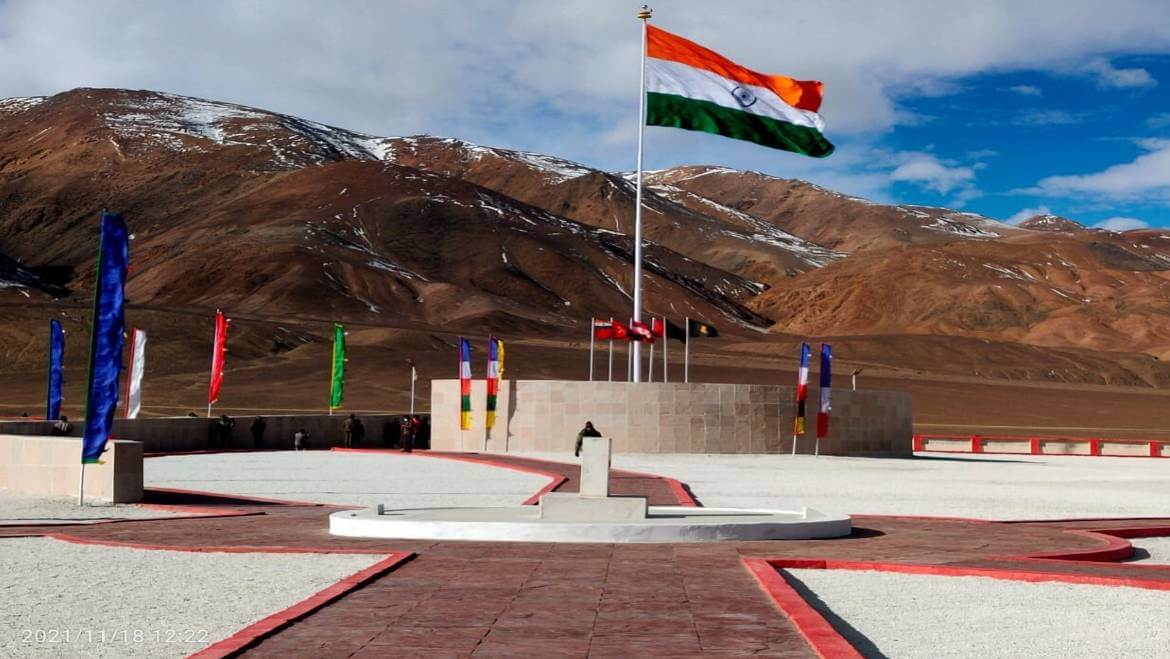
The Indian Army stationed soldiers along the Border Line of Actual Control south of the Pangong Tso during the summer border standoff, particularly at Rezang La and Rechin La. They would have an unobstructed view of the Spanggur Gap with China’s “Moldo sector” (deployments near Spanggur Lake) as a result, it was said.
Rezang La War Memorial at Chushul
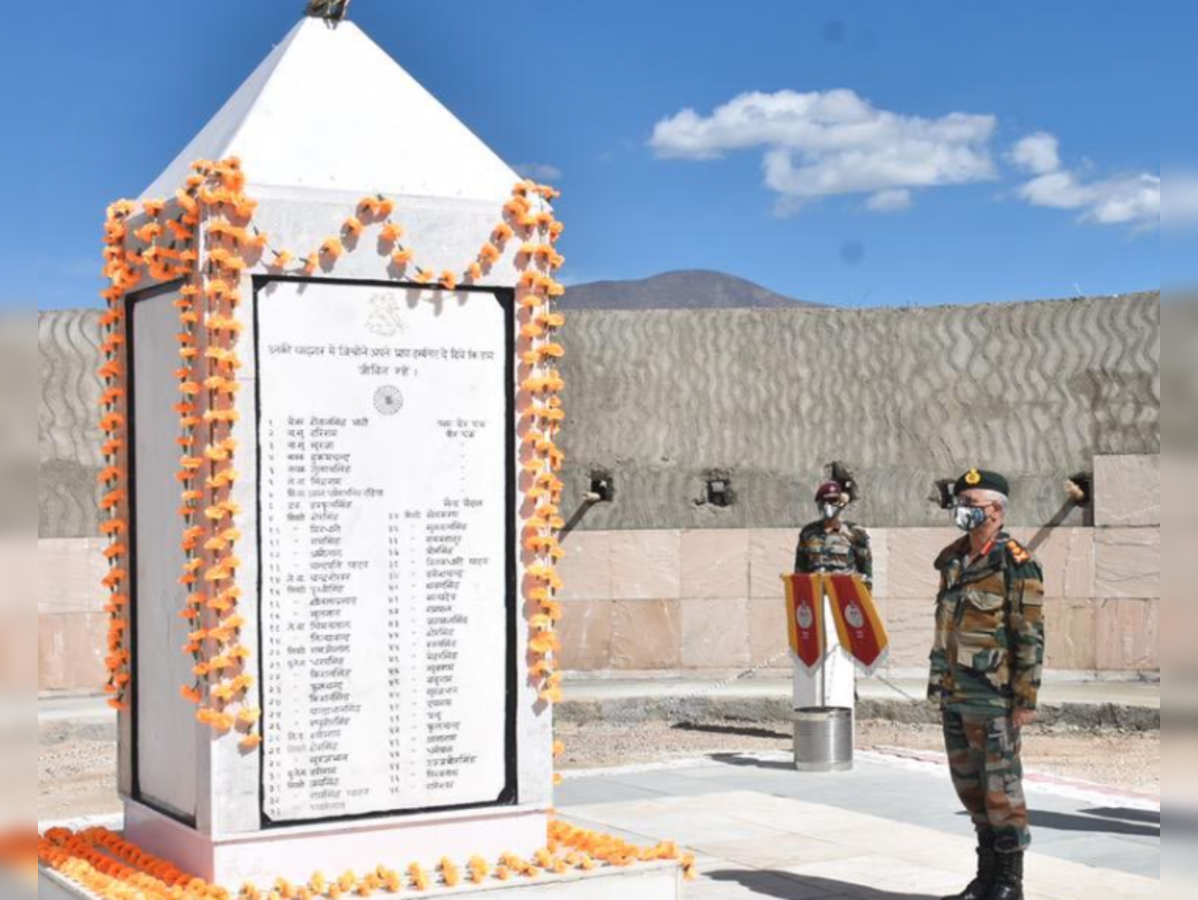
The Indian Army erected a war memorial in Chushul, Ladakh, in honour of the men who lost their lives during the Battle of Rezang La. Its inscription is as follows. The first four words of the poem Horatius by Thomas Babington Macaulay, who served as the Governor-General of India from 1834 to 1838, are used in this passage.
How can a man die better,
Than facing fearful odds,
For the ashes of his fathers,
And the temples of his gods.
To the sacred memory of
the heroes of Rezang-La
114 martyrs of 13 Kumaon
who fought
to the last man last round
against hordes of Chinese
on
18 November 1962.
Built by all ranks
13th Battalion the Kumaon Regiment.
Have you heard of Baba Harbhajan Singh? His story will give you goosebumps! A Soldier Protecting The Borders Even After Death!! Baba Harbhajan Singh.
Rezang La War Memorial at Rewari
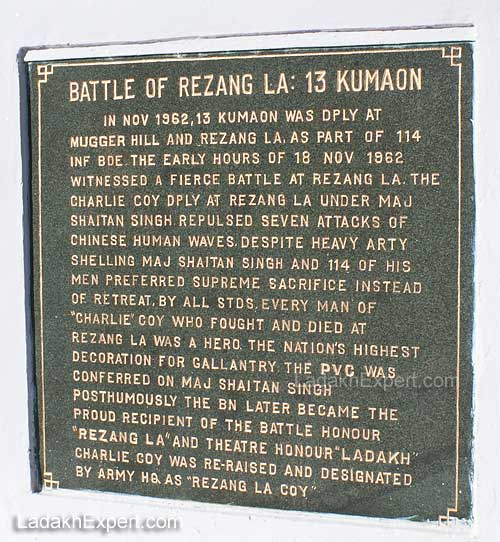
In honour of the soldiers who were primarily from the Ahirwal region of Haryana, General K S Thimayya wants to see a memorial constructed there. He believed that future generations would look to the tremendous bravery and chivalry of their ancestors for inspiration. The Samiti organises an annual memorial service every year in conjunction with the district administration, the Kumaon Regiment, and survivors’ families. The two bravest soldiers, Capt. Ram Chander Singh and Hav Nihal Singh, will be the featured speakers at all special and cultural events in Delhi-NCR and Rewari. They will recount the Rezang La story to inspire the next generation with the “Veer Ahirs”‘ bravery.
Some Frequently Asked Questions
The nation as a whole can draw a lot of inspiration from the Rezang La struggle. As a member of the 114 Infantry Brigade, the 13 KUMAON was sent to Magar Hill and Rezang La in the Chushul Sector of Eastern Ladakh in November 1962. Despite overwhelming odds and being significantly outnumbered, the brave men of the ‘C’ Company, 13 KUMAON, successfully repelled seven Chinese assaults. In the high Himalayas of Ladakh on November 18, 1962, 13 Kumaon’s C Company staged a valiant last stand against the Chinese forces, repelling a very serious threat and opening a great new chapter in India’s military history.
1962 Rezang La combat.
At Rezang La Pass in Ladakh, India, on November 18, 1962, the Charlie Company of the 13 Kumaon Battalion, Kumaon Regiment, beat off a Chinese assault. 120 troops made up the company, which was commanded by Major Shaitan Singh. 110 of these troops perished in the assault as martyrs. Rezang La served as the scene of the Charlie ‘C’ Ahir company of 13 Kumaon’s final stand during the 1962 Sino-Indian War, which included 124 Indian soldiers.
Logistics would have made it simpler for India to mobilise reserve formations outfitted with heavy artillery and tanks at the extended sites in Assam that the PLA reached on November 20, 1962. Without a way to retreat across the Himalayas, the PLA was confronted with the unpalatable prospect of facing US-equipped Indian soldiers. The PLA decided to quit while they were ahead and proclaimed victory before retreating to Tibet.
Chushul is one of the five locations for Border Personnel Meetings that have been formally established between the Indian Army and the People’s Liberation Army of China for the purpose of enhancing cooperation. Eastern Ladakh’s Chushul sub-sector is located south of Pangong Tso.
Along with crossings like Rezang La and Reqin La, the Spanggur Gap, and the Chushul Valley, it includes high, broken mountains and heights like Thatung, Black Top, Helmet Top, Gurung Hill, and Magger Hill. The Chushul Valley, located at a height of nearly 13,000 feet close to the LAC, features a crucial airfield that was crucial even during the 1962 War with China.
Know all about the Battles That Changed Indian History Forever

